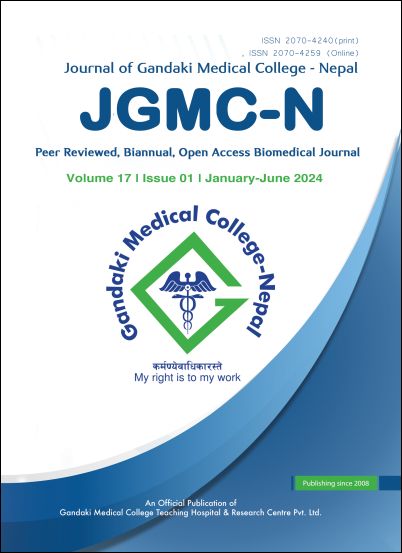Prevalence and determinants of acute respiratory infections among under-five children in a tertiary care center at Pokhara, Nepal
DOI:
https://doi.org/10.3126/jgmcn.v17i1.63300Keywords:
Acute respiratory infections, determinants, prevalence, under-fiveAbstract
Introduction: Acute respiratory infection (ARI) is a major determinant of morbidity and mortality among under-five children in developing countries. Despite decreasing trends in childhood morbidity and mortality, ARI remains a significant predictor of recurrent illness and hospitalization among under-five children in Nepal. This study was conducted to assess the prevalence and determinants of ARI among under-five children at a tertiary care center at Pokhara, Nepal.
Methods: An analytical cross-sectional study was conducted among 358 mother-child dyads who were recruited through a purposive sampling technique and data was collected through the computer-assisted personal interview (CAPI) technique. Descriptive and inferential statistics were used. The level of statistical significance was set at p<0.05.
Results: The prevalence of ARI among under-five was 39.38%. The age of the child (AOR=8.37, 95% CI:5.00–13.99), being male (AOR=3.13,95% CI: 2.00–4.86), mother’s education below secondary level (AOR=2.28, 95% CI:1.39–3.73), child with no EBF (AOR=1.86, 95% CI:1.21–2.86), stunted child (AOR=2.99, 95% CI: 1.93–4.64), wasted child (AOR=2.66, 95% CI:1.71–4.12), passive smoking by child (AOR=2.43, 95% CI: 1.49–3.97), having no separate kitchen (AOR=0.18, 95% CI: 0.11–0.29) were found to be significant determinants of ARI.
Conclusions: More than 1/3rd of the under-five children had ARI. Age and gender of the child, maternal education, breastfeeding and nutritional status of the child, passive smoking, not having a separate kitchen, and using wood as a cooling fuel were the determinants of ARI among under-five children. The occurrence can be minimized by improving households, the nutritional status of children, and by increasing awareness regarding its prevention and management.
Downloads
Downloads
Published
How to Cite
Issue
Section
License
Copyright (c) 2024 The Author(s)

This work is licensed under a Creative Commons Attribution-NonCommercial 4.0 International License.
This license allows reusers to distribute, remix, adapt, and build upon the material in any medium or format for noncommercial purposes only, and only so long as attribution is given to the creator.




